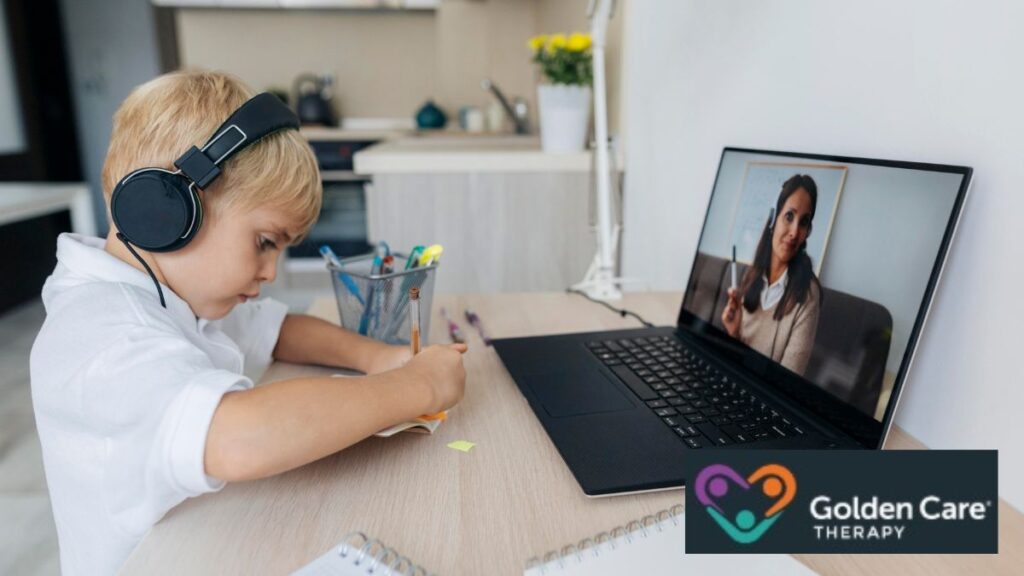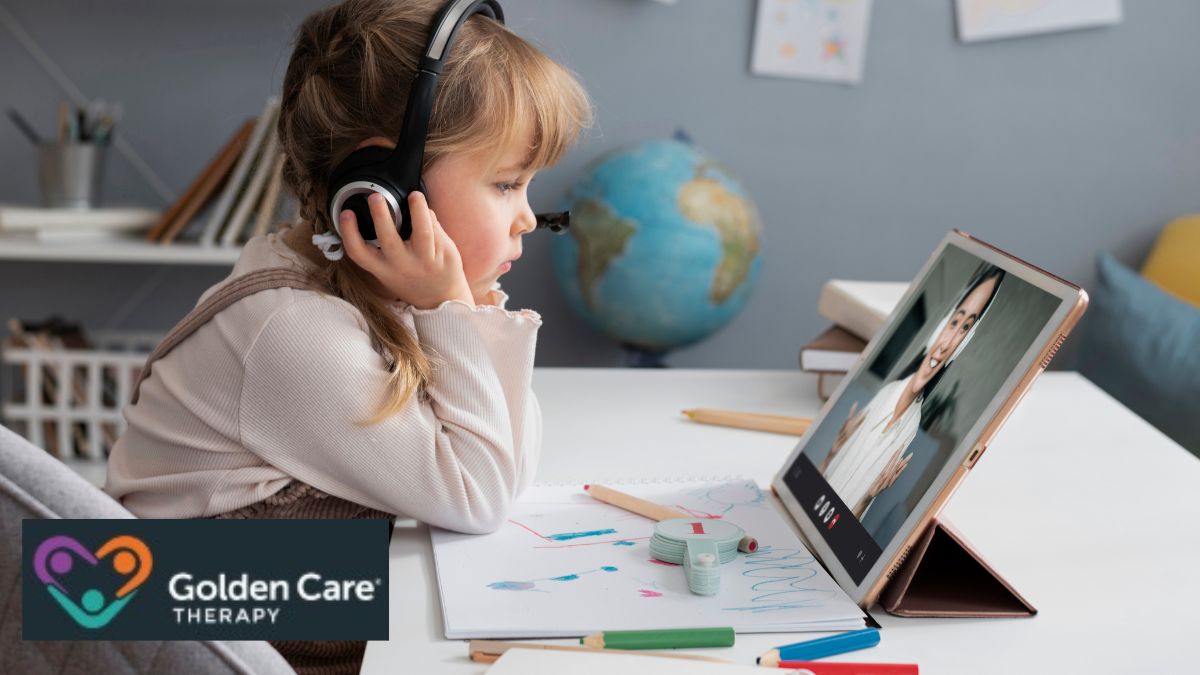Imagine sitting on your couch while your child works with a licensed therapist. That’s the simplicity of ABA therapy online. Sessions happen through secure video calls and digital tools, bringing therapy right to your home. Families want support that fits their lives. Telehealth ABA does just that. No more long drives, missed work, or rushed schedules. Instead, therapy happens in a space your child knows and feels safe.
So, how does online autism therapy really work? Many parents say it helps them stay engaged and actively involved in their child’s progress. This blog explores how technology is helping families learn, why virtual ABA is gaining attention, and how it could shape the future of autism support, all in a friendly, easy-to-follow way.
Telehealth ABA: What Is It?

What does “telehealth ABA” mean? Simply put, it’s evidence-based autism therapy delivered remotely. Children, caregivers, and therapists connect through video calls, web apps, or digital platforms. This includes virtual parent coaching, therapist-led sessions, and real-time progress tracking.
Why does this matter? Traditional therapy often meant long trips, strict schedules, and limited access. With telehealth ABA, those barriers shrink. Research shows its potential: a review of 28 studies found telehealth ABA improved at least one key outcome in every study (Ferguson et al., 2019). Remote direct therapy can help skills learned by the individual carry over to family members, supporting practical use at home. (Nohelty et al., 2021).
Key features of telehealth ABA include:
- Remote sessions: Secure video calls let therapists work with families from home.
- Parent or caregiver involvement: Parents receive coaching during daily routines.
- Data collection & feedback: Apps and digital tools track progress in real-time.
- Flexibility: Sessions can fit your family’s schedule and home life.
Telehealth ABA blends therapy with family-friendly support, making interventions more accessible and easier to maintain.
Online Autism Therapy: What to Expect

What does a journey into virtual ABA look like? Here’s a simple guide.
1. Getting set up
Your child starts with an assessment, just like in-person therapy. The therapist gathers information about strengths, challenges, routines, and goals. Sessions are scheduled online.
You don’t need complicated tech: just a device with a camera and microphone, stable internet, and a quiet, private space. Many families find therapy in a familiar setting reduces stress and increases engagement.
2. Therapy sessions
Whether it’s therapist-led or parent-guided, you’ll see core ABA strategies in action: reinforcement of positive behaviors, shaping new skills, prompting and fading, and natural environment teaching (NET).
Research supports this approach. Telehealth ABA interventions are effective after parents receive initial training (Micai et al., 2024).
3. Parent training
Remote therapy increases parental participation. Parents trained via telehealth can reach high fidelity in applying strategies and often rate the training highly (Ferguson, Dounavi & Craig, 2022). You’ll likely observe, implement strategies, track progress, and collaborate with the therapist.
4. Natural setting, real-life results
Sessions in the home encourage generalization, helping skills transfer more easily to daily routines and everyday situations (Nohelty et al., 2021).
5. Ongoing monitoring & flexibility
Digital dashboards, check-ins, and progress summaries make it easy to adapt schedules, maintain momentum, and respond to changes.
6. Questions families often ask
- Will my child engage over a screen? Many children do, thanks to familiar surroundings.
- Is it as effective as in-person therapy? Studies show comparable outcomes. One study found cognitive and motor results similar for online vs. in-person sessions, though language slightly favored in-person (Bajracharya et al., 2024).
- What tech is required? Stable internet, camera, mic, and quiet space suffice.
- Who leads the session? Some programs are therapist-led, some parent-coach led, and many use a hybrid approach.
The takeaway: ABA therapy online is not a compromise. With proper support, it delivers strong, meaningful outcomes.
ABA Therapy Georgia and ABA Therapy Indiana: Why Location Still Matters
Even with telehealth, location can affect therapy. Here’s why:
Coverage, regulations, and availability
States differ in telehealth laws, insurance coverage, and licensing. A provider must be licensed in your state. If you’re looking for ABA therapy Georgia or ABA therapy Indiana, check insurance coverage and local support networks.
Local access to in-person supports
Sometimes hybrid models work best, occasional in-person visits combined with remote sessions. Having nearby clinics or behavior analysts provides backup for complex needs.
Community resources and school coordination
Providers familiar with your state can coordinate therapy with schools, early intervention programs, and local resources. This makes therapy smoother and more effective.
Real-life example
A rural Indiana family may have faced hours of travel for traditional therapy. Remote sessions allow daily support without long trips. Occasional in-person check-ins strengthen outcomes. Hybrid approaches give families flexibility and access.
Summary
When searching for aba therapy near me or online options:
- Is the provider licensed in your state?
- Does insurance cover telehealth there?
- Are local resources available for in-person support?
- Does the provider integrate home routines, school coordination, and local context?
Location matters, but in a way that empowers families rather than limits them.
How Technology is Changing ABA Therapy for Families
Telehealth ABA isn’t just video calls. Technology is transforming therapy in meaningful ways.
Data collection & analytics
No more paper notes. Digital tools allow:
- Real-time behavior tracking via apps
- Cloud-based reporting for families and therapists
- Analytics to highlight trends and areas needing focus
A systematic review found telehealth ABA interventions produced measurable improvements, even with varying study quality (Ferguson et al., 2019). Real-time data helps therapists adjust quickly and tailor sessions to each child.
Engaging tools & gamification
Interactive apps and gamified tasks make sessions fun and engaging. A pilot study found gamified ABA tools improved focus and reduced non-therapeutic time in children ages 4–7 (Cordioli et al., 2023).
Wearables, sensors & monitoring
Wearable devices track physical activity, sleep, or stress responses. These insights let therapists adapt strategies based on daily life, not just therapy sessions.
Virtual reality (VR) and immersive environments
VR simulations allow children to practice social skills, waiting their turn, or navigating public spaces safely. It adds a new layer to online autism therapy beyond screen-based activities.
Telepresence and hybrid models
Telepresence robots or smart cameras let therapists “enter” the room remotely, allowing direct engagement or supervision. Research shows these tools are effective in remote ABA (Ferguson et al., 2019).
Why it matters
- Therapy is more consistent, even when travel is tough.
- Skills generalize naturally because therapy occurs at home.
- Parents become active partners in care.
- Flexibility improves for schedule, session type, and integration with daily routines.
Technology isn’t just a substitute; it’s a catalyst for personalized, effective therapy.
Benefits at a Glance
Here’s why families and therapists love telehealth ABA, virtual ABA, remote ABA, and online autism therapy:
| Benefit | How it Helps Families |
| Increased access | Rural or underserved families receive care |
| Flexibility & convenience | Less travel, schedule fits home life |
| Enhanced caregiver involvement | Parents learn and implement strategies in real time |
| Natural environment learning | Therapy happens where skills are needed most |
| Cost-effectiveness | Reduced overhead, more consistent sessions |
| Better data & monitoring | Real-time analytics support progress tracking |
Families can support children more efficiently and effectively with these tools.
Future Outlook: Where It’s Heading
What’s next for ABA therapy online, ABA therapy Indiana, and ABA therapy Georgia?
- AI and predictive analytics: Machine learning will help spot patterns, anticipate challenges, and tailor interventions.
- Immersive tech: VR, AR, robotics, and sensors will make therapy more interactive and engaging.
- Data-driven personalization: Therapy will feel built specifically for your child.
- Hybrid models: A mix of in-person, remote, and digital sessions will become standard.
- Broader coverage: As telehealth proves effective, insurers and states may expand coverage, improving access everywhere.
Families exploring services in ABA therapy in New York, ABA therapy New Jersey, Georgia, or Indiana are entering a rapidly evolving, flexible, and technology-driven era of autism care.
FAQ: Your Questions Answered
- Can a child still make progress via video?
Yes. Remote ABA and caregiver-mediated training produce measurable gains in communication, behavior, and skills.
- Do I need fast internet or special equipment?
No. A stable device with camera, microphone, and quiet space is enough. Most platforms are built for home use.
- Is remote therapy as effective as in-person?
Often, yes. Caregiver training and home-based interventions match in-person outcomes for many skills. One study slightly favored in-person language outcomes (Bajracharya et al., 2023).
- Does my state matter?
Yes. Check licensure, insurance coverage, and local support. Hybrid models often work best in states like New York, New Jersey, Georgia, and Indiana.
- How do I know if remote ABA fits my child?
Ask about caregiver involvement, home-focused routines, data tracking, and hybrid options. A good provider customizes the plan to your child and family.
Taking the Next Step in Virtual ABA Support

Technology and telehealth are opening doors for families who need flexible, effective therapy. With Golden Care, your child can access ABA therapy online and virtual ABA options that fit your home life and daily routines. Families in Indiana and beyond are finding that therapy adapts to their schedule, their child’s pace, and their unique goals.
Providers like Golden Care focus on meaningful, personalized growth every day. Caregivers stay involved, data tracks progress, and sessions happen where children feel most comfortable, at home. Whether you’re exploring telehealth ABA, remote ABA, or online autism therapy, support can be tailored just for your family.Curious how it could work for your child? Reach out to us today to learn more and discover a path toward confidence, progress, and care that truly fits your life.



